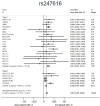Meta-analysis of genome-wide association studies of HDL cholesterol response to statins
- PMID: 27587472
- PMCID: PMC5309131
- DOI: 10.1136/jmedgenet-2016-103966
Meta-analysis of genome-wide association studies of HDL cholesterol response to statins
Abstract
Background: In addition to lowering low density lipoprotein cholesterol (LDL-C), statin therapy also raises high density lipoprotein cholesterol (HDL-C) levels. Inter-individual variation in HDL-C response to statins may be partially explained by genetic variation.
Methods and results: We performed a meta-analysis of genome-wide association studies (GWAS) to identify variants with an effect on statin-induced high density lipoprotein cholesterol (HDL-C) changes. The 123 most promising signals with p<1×10-4 from the 16 769 statin-treated participants in the first analysis stage were followed up in an independent group of 10 951 statin-treated individuals, providing a total sample size of 27 720 individuals. The only associations of genome-wide significance (p<5×10-8) were between minor alleles at the CETP locus and greater HDL-C response to statin treatment.
Conclusions: Based on results from this study that included a relatively large sample size, we suggest that CETP may be the only detectable locus with common genetic variants that influence HDL-C response to statins substantially in individuals of European descent. Although CETP is known to be associated with HDL-C, we provide evidence that this pharmacogenetic effect is independent of its association with baseline HDL-C levels.
Keywords: Genome-wide association study; HDL-cholesterol; Statins; pharmacogenetics.
Published by the BMJ Publishing Group Limited. For permission to use (where not already granted under a licence) please go to http://www.bmj.com/company/products-services/rights-and-licensing/.
Conflict of interest statement
Competing financial interests: BMP serves on the Data and Safety Monitoring Board of a clinical trial funded by the device manufacturer (Zoll LifeCor) and serves on the Steering Committee of the Yale Open Data Access Project funded by Johnson & Johnson. NP and AS received funding from Pfizer for the extended follow-up of the ASCOT UK participants. DIC and PMR received research support for independent genetic analysis in JUPITER from AstraZeneca. FN and BJB have employment, stock and stock options in AstraZeneca, a for-profit company engaged in the discovery, development, manufacture and marketing of proprietary therapeutics such as rosuvastatin, but do not consider that this creates any conflict of interest with the subject-matter of this publication. RMK serves on the Merck Global Atherosclerosis Advisory Board. The remaining authors declare no competing financial interests.
Figures




References
-
- Davidson MH, Toth PP. Comparative effects of lipid-lowering therapies. Prog Cardiovasc Dis. 2004;47(2):73–104. - PubMed
-
- Baigent C, Blackwell L, Emberson J, Holland LE, Reith C, Bhala N, Peto R, Barnes EH, Keech A, Simes J, Collins R. Efficacy and safety of more intensive lowering of LDL cholesterol: a meta-analysis of data from 170,000 participants in 26 randomised trials. Lancet. 2010;376(9753):1670–81. - PMC - PubMed
-
- Nicholls SJ, Tuzcu EM, Sipahi I, Grasso AW, Schoenhagen P, Hu T, Wolski K, Crowe T, Desai MY, Hazen SL, Kapadia SR, Nissen SE. Statins, high-density lipoprotein cholesterol, and regression of coronary atherosclerosis. JAMA. 2007;297(5):499–508. - PubMed
Publication types
MeSH terms
Substances
Grants and funding
- N01 HC095161/HL/NHLBI NIH HHS/United States
- HHSN268201100010C/HL/NHLBI NIH HHS/United States
- HHSN268201100011I/HL/NHLBI NIH HHS/United States
- N01 HC095159/HL/NHLBI NIH HHS/United States
- Z01 AG007380/ImNIH/Intramural NIH HHS/United States
- N01 HC085079/HL/NHLBI NIH HHS/United States
- N01 HC095166/HL/NHLBI NIH HHS/United States
- N01 HC085081/HL/NHLBI NIH HHS/United States
- N01 HC095160/HL/NHLBI NIH HHS/United States
- HHSN268201100012C/HL/NHLBI NIH HHS/United States
- UL1 RR033176/RR/NCRR NIH HHS/United States
- R01 HL103612/HL/NHLBI NIH HHS/United States
- UL1 TR000445/TR/NCATS NIH HHS/United States
- HHSN268201100009I/HL/NHLBI NIH HHS/United States
- N01 HC085080/HL/NHLBI NIH HHS/United States
- N01 HC095168/HL/NHLBI NIH HHS/United States
- R01 HL120393/HL/NHLBI NIH HHS/United States
- UL1 RR025005/RR/NCRR NIH HHS/United States
- N01 AG062101/AG/NIA NIH HHS/United States
- HHSN268201100008C/HL/NHLBI NIH HHS/United States
- U01 HL080295/HL/NHLBI NIH HHS/United States
- N01 HC095169/HL/NHLBI NIH HHS/United States
- HHSN268201100008I/HL/NHLBI NIH HHS/United States
- HHSN268201100005G/HL/NHLBI NIH HHS/United States
- N01 HC085082/HL/NHLBI NIH HHS/United States
- R01 HL068986/HL/NHLBI NIH HHS/United States
- R01 HL059367/HL/NHLBI NIH HHS/United States
- HHSN268201100007C/HL/NHLBI NIH HHS/United States
- HHSN268200800007C/HL/NHLBI NIH HHS/United States
- N01 HC085086/HL/NHLBI NIH HHS/United States
- R01 HL085251/HL/NHLBI NIH HHS/United States
- N01 HC085083/HL/NHLBI NIH HHS/United States
- HHSN268201100011C/HL/NHLBI NIH HHS/United States
- R01 HL086694/HL/NHLBI NIH HHS/United States
- U01 HG004603/HG/NHGRI NIH HHS/United States
- DH_/Department of Health/United Kingdom
- UL1 RR024156/RR/NCRR NIH HHS/United States
- 085475/B/08/Z/WT_/Wellcome Trust/United Kingdom
- N01 HC095167/HL/NHLBI NIH HHS/United States
- R01 HL087652/HL/NHLBI NIH HHS/United States
- U01 HG004402/HG/NHGRI NIH HHS/United States
- UL1 TR000124/TR/NCATS NIH HHS/United States
- N01 AG062106/AG/NIA NIH HHS/United States
- R01 HL105756/HL/NHLBI NIH HHS/United States
- R01 AG032098/AG/NIA NIH HHS/United States
- P30 DK063491/DK/NIDDK NIH HHS/United States
- HHSN268200782096C/HG/NHGRI NIH HHS/United States
- HHSN268201100006C/HL/NHLBI NIH HHS/United States
- HHSN268201200036C/HL/NHLBI NIH HHS/United States
- 084727/Z/08/Z/WT_/Wellcome Trust/United Kingdom
- N01 HC025195/HL/NHLBI NIH HHS/United States
- N01 HC055222/HL/NHLBI NIH HHS/United States
- HHSN268201100005I/HL/NHLBI NIH HHS/United States
- N01 AG062103/AG/NIA NIH HHS/United States
- N01 HC095163/HL/NHLBI NIH HHS/United States
- U24 AG051129/AG/NIA NIH HHS/United States
- P50 GM115305/GM/NIGMS NIH HHS/United States
- 085475/Z/08/Z/WT_/Wellcome Trust/United Kingdom
- R01 HL043201/HL/NHLBI NIH HHS/United States
- U19 HL069757/HL/NHLBI NIH HHS/United States
- MR/K006584/1/MRC_/Medical Research Council/United Kingdom
- HHSN268201100009C/HL/NHLBI NIH HHS/United States
- HHSN268201100005C/HL/NHLBI NIH HHS/United States
- HHSN268201100007I/HL/NHLBI NIH HHS/United States
- UL1 RR024975/RR/NCRR NIH HHS/United States
- WT_/Wellcome Trust/United Kingdom
- N01 HC095162/HL/NHLBI NIH HHS/United States
- R01 AG023629/AG/NIA NIH HHS/United States
- R01 HL087641/HL/NHLBI NIH HHS/United States
- R01 HL073410/HL/NHLBI NIH HHS/United States
- P2C HD050924/HD/NICHD NIH HHS/United States
- N01 HC095165/HL/NHLBI NIH HHS/United States
- G0600237/MRC_/Medical Research Council/United Kingdom
- N01 HC095164/HL/NHLBI NIH HHS/United States
LinkOut - more resources
Full Text Sources
Other Literature Sources
Medical
Molecular Biology Databases
